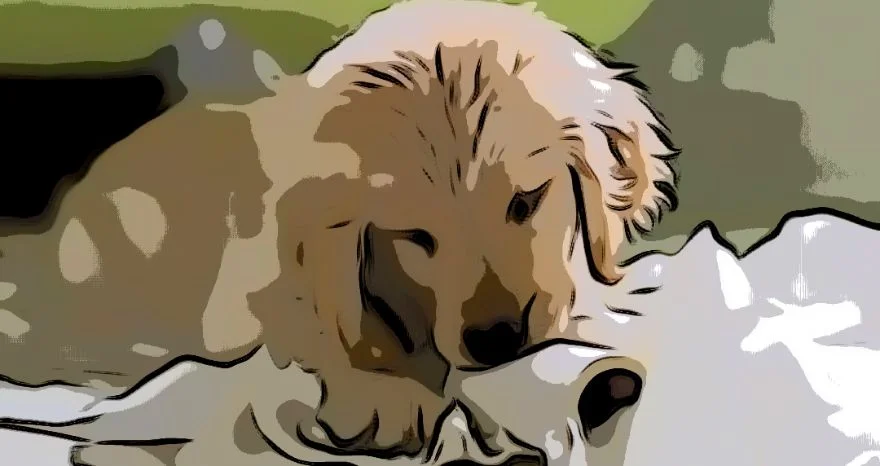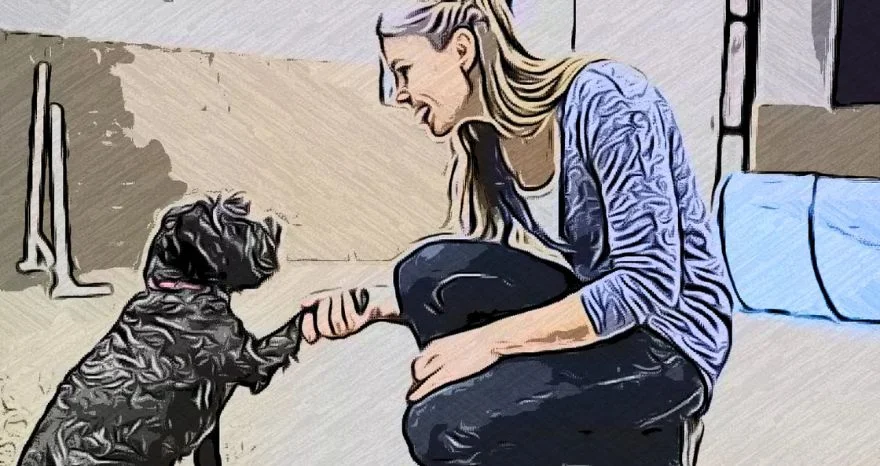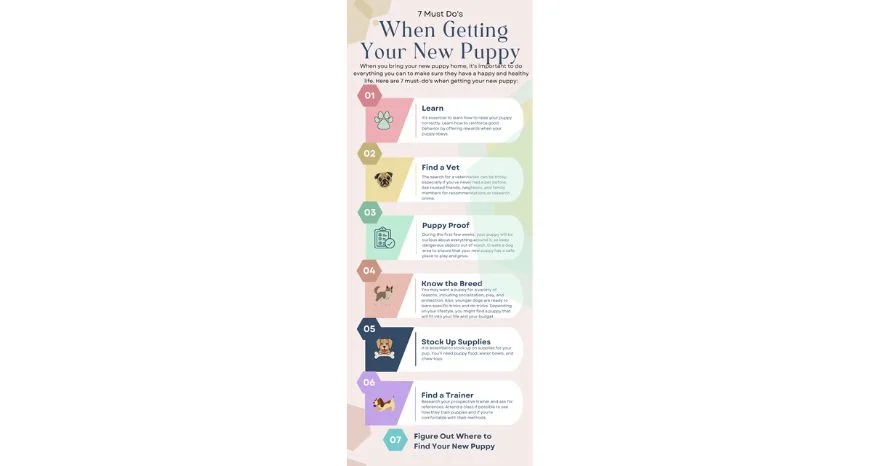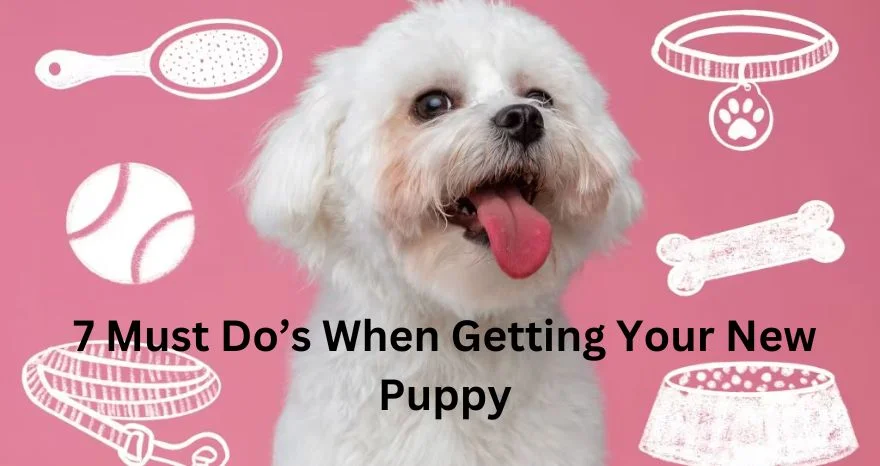When you get a new puppy, there are several things that you need to do right away.
When you bring your new puppy home, it’s important to do everything you can to make sure they have a happy and healthy life.
Here are 7 must-do’s when getting your new puppy:
1. Learn How to Raise Your Puppy Correctly
It is essential to know how to properly train your puppy to behave. This can be done in a number of ways. A few simple commands will do the trick.
You need to learn how to reinforce good behavior by offering rewards when your puppy obeys. You can also use food as a reward when your puppy reaches a milestone.
This is to be done when your puppy sits when you want it to. You can do this by raising your hand above the puppies head and then saying, “sit”. The puppies nose follows the physical direction always before the verbal, so, where the nose goes the bum goes the other direction. Puppies nose goes up, puppies bum then goes down resulting in the side. You then mark the behavior with either a verbal marker “Yes” or a Clicker, then you reward with food/treat.

Marking the behavior has to be within a second on the puppy performing that behavior which is why the verbal marker or clickers are used. Then you ‘Pay’ the dog, the treat doesn’t have to be within the second if the puppy becomes conditioned to the marker. Repeat this process until your puppy sits on his own. After he’s learned the command, move on to more challenging commands and use your hand to guide him.
Luring and Shaping behaviors is always a great way to train your puppy. We will have training content soon to help show you ways to teach your dog commands.
This is usually achieved well if you’ve learned the behaviors and commands you want to implement prior to bringing your puppy home.
2. Find the Right Veterinarian
The search for a veterinarian can be tricky, especially if you’ve never had a pet before. The first step is to ask trusted friends, neighbors, and family members for recommendations. Getting more than one opinion is helpful, as you don’t want to choose someone who everyone hates.
However, if you can, research veterinarians online as well. By doing so, you can narrow down your list to a handful of candidates.
During your first visit to the veterinarian, don’t be afraid to ask questions. The veterinarian can discuss vaccinations, heartworm prevention, and flea and tick control with you.
Another factor is proximity. Having a veterinarian close by will make well visits easier and give you peace of mind in the event of an emergency.
For your puppies first visit at least, it needs to be a completely positive experience. You should organize with the vet a time to bring them in, socialize the puppy to the environment, meet the vets, have some positive experiences so your puppy enjoys and looks forward to going to the vets.
You do not want your puppy’s first experience of going into a vet where they are stuck with needles and handled too much when it is not comfortable. This will create a negative association for the puppy and all future experiences could lead to your puppy hating the vet and being anxious every time you come for an appointment.
Never underestimate the power of socialization, in all areas!
3. Puppy-Proof Your Home

If you have other pets or children, make sure to reinforce the “come” and “stay”/”place” commands with your puppy. During the first few weeks, your puppy will be curious about everything around it, so keep dangerous objects out of reach.
Creating a dog area in your home is important to ensure that your new puppy has a safe place to play and grow. Make sure to cover any electrical cords that may be chewed. Also, place all children’s toys out of reach. Puppies like to explore with their mouths, so make sure to place these items far away from your puppy’s reach.
This is where Crate training your puppy is crucial. Dogs are den animals and like their own safe space to relax and be calm. Crates are not for punishment. Your puppy should either be in it’s crate or an ex-pen when you are unable to give it the attention and supervision it needs.
Would you leave your little baby to crawl and walk around the home completely unattended to explore and do what it wishes? I would think so. This is the same for your puppy, you do not want your puppy to learn any unwanted behaviors that will be a lot harder to get out of the puppy when it becomes a fully grown dog. Do not set your puppy for failure.
When the puppy is out of its crate or ex-pen you need to be able to supervise them. This also includes outside. A long line (With no loop on the end of the lead) and a flat buckle collar allows your puppy to wander and explore without going too far or running off. This is crucial when you want to teach your puppy recall and ‘leave it’.
In addition, close off rooms you do not want your puppy going into or exploring.. Your new puppy will feel more comfortable in his new home when you take the time to prepare. Set the right boundaries and expectations from the start, being vigilant and consistent, not setting your puppy up to fail and you will reap the rewards 10 fold once the puppy stage is over.
4. Find Out What Kind of Puppy Is Right for You?
First, decide what age you want your new dog to be. Young puppies and adult dogs cost more money than older dogs, but older dogs are typically already potty trained and need less training.
You may want a puppy for a variety of reasons, including socialization, play, and protection. Also, younger dogs are ready to learn specific tricks and do tricks. Depending on your lifestyle, you might find a puppy that will fit into your life and your budget.
Once you’ve selected the size, gender, and personality of your puppy, the next step is finding the litter of puppies available in your area. Then, you need to consider what sort of home you have. Consider how much space you have to devote to play and exercise and how much money you have to spend on healthcare.
If you’re buying a puppy for a family, you may want a medium-sized breed with less energy and more cuddle time.
5. Stock Up on Puppy Supplies
When getting a new puppy, it is essential to stock up on supplies for your pup. You’ll need puppy food, water bowls, and chew toys. You will also need a feeding mat to keep your floors clean.
When choosing a feeding bowl, look for stainless steel models that are easy to clean. If you have a kitchen, invest in a feeding platform. Puppy food comes in many different varieties, and a platform will allow your puppy to eat comfortably.
Puppies have a strong chewing urge. Especially when their teeth first come in, chewing can be dangerous. To avoid this, be sure to provide a chewing bone that is safe for your pup to chew on. It’s best to buy compressed rawhides rather than ones that have been twisted. Twisted rawhide can break, choking a pup. Replace the chew toy as soon as you start to notice the toy showing signs of damage.
Moreover, you should purchase grooming wipes, shampoo, and nail clippers. Make sure to buy dog training treats for rewarding good behavior. You should also invest in a dog crate and an exercise pen to block off areas where your puppy can run around. You should also purchase poop bags for your pup’s walks.
A clicker, treat pouch, flat buckle and martingale collar along with a 6ft and 15ft leads are always great to have in your tool kit for training and educating your puppy.
6. Find A Good Trainer Or Class

Before enrolling in a class, research your prospective trainer and ask for references. Attend a class if possible to see how they train puppies and if you’re comfortable with their methods.
Look for a trainer who uses balanced training methods, focusing on Operant and Classical Condition methods of reinforcement and avoids yelling and harsh methods. If you can’t observe a class, ask around or read online reviews. In addition to asking around, you can also ask your friends and family for recommendations.
Look for a class or trainer that will provide more than just basic training techniques. You’ll want to learn about the nuances of dog communication, learning, and behavior. Good classes also offer socialization.
You’ll also want to look for advice on grooming and avoiding common dog behavior issues. Some trainers will train older dogs as well. You can always ask other pet owners for a referral.
While you’re looking for a trainer, consider how many other puppies will be in the class. If the class has a maximum of five students, you can be confident that your dog is getting individual attention.
Authors Note: Pet Daily Press is a very reputable website that has a lot of traffic, so you can be sure that you’ll be able to reach a wide audience if you sell puppies on Pet Daily Press. Finally, it offers a lot of support to its sellers, so you can be sure that you’ll be able to get the help you need if you run into any problems.
7. Where to Find Your New Puppy
When you are considering adopting a new puppy, one of the first steps is to decide where to get your pup.
You can choose to adopt from a shelter or rescue organization. Both options have their advantages and disadvantages.
While a shelter or rescue organization’s adoption fee may be higher than a regular breeder, these organizations often cover medical costs and provide pet adoption counselors to make sure the puppy is a good match for your household. They also teach you how to take care of your new puppy.
However, Pet Daily Press is a great place to find your new fiddo.
Pet Daily Press is the perfect place to sell puppies. They offer a variety of services that make it easy for you to find the perfect home for your pup.
They also have a wide selection of breeds to choose from, so you’re sure to find the perfect pup for your family. Plus, their prices are unbeatable. You won’t find a better place to sell or buy puppies than Pet Daily Press.
Must Do’s After Bringing a Puppy Home

Once your dear new family member is home, some of the first things you need to do are:
1. Potty Training
One of the first things you need to do is to potty train your puppy. Puppies have a very small bladder, so they need to go potty a lot.
This is where the right size crate and crate training is critical. Your puppy will never go potty where it sleeps, so the crate cannot be too big for your puppy so that it goes potty in the back of the crate and sleeps in the front.
Your puppy should be taken outside every hour on the hour initially and taken to where you want it to go potty. Give your puppy the time to go, teaching the ‘potty’ command, when they go, mark the behavior with “good, potty’ praise etc. Do not always bring your puppy straight back inside after, otherwise your puppy might try to hold longer if it thinks it’s always going to go straight back inside after it goes.
Generally the rule of thumb is, the puppies ages in months + 1 is the hours a puppy can hold for. For example your 8 week puppy is 2 months old +1 = 3 hours it should be able to hold for. When your puppy first comes home, I would spend the first couple weeks working off the every hour rule unless until crate trained then at night you can extend time in between potty breaks.
The aim is to never let your puppy have an accident inside or where you do not want it to go.
Try to stay calm, and make sure to take your new puppy outside as often as possible. Reward your puppy for successful potty trips with treats, praise, and head pats.
2. Socialize the Puppy
Introduce your new puppy to other animals in the household.
The puppy will be more comfortable if you use this method of introducing your new dog to other animals. You should also prepare a special place for your puppy’s food and water bowl.
Try to start socializing with your new puppy the second it comes home. The first 16 weeks of a puppies phase is its imprinting phase. No phase is more important than these first 16 weeks of your puppy’s life. This will set up the type of dog you will have for the rest of its life.
Your dog alone in the first month should see around 1,000 different types of people/faces. Babies, children, adults, elderly of all shapes, sizes, ethnicity etc.
This may seem like a lot but it really isn’t. Some warehouse visits in a trolley, walking past some schools at the end of the day, a trip around the train station, cafe’s etc.
Socialization doesn’t mean your puppy needs to meet all these people and play with them and get pats etc. That is not socialization at all, it simply means exposure to these people, seeing and being around as many varieties of people, places and other animals as possible in the first 16 weeks is what will give you the most balanced dog possible. These experiences need to be fun, short and always a positive experience for the best results.
Stay away from off lead dog parks at all costs!
3. Leash Training

Train your puppy to walk on a leash. Leash training should be started before you take your new puppy outside. It’s best to lure your puppy with a treat and praise it when it gets to you.
Never take your puppy for long walks when it is young. With larger breeds especially you should never force long walks for the first 18 months. As a puppy 5-10min walks it all it will need. Games and engagement in the back yard is more important and training.
You can allow your puppy to run around outside as much as it likes, but for joint development do not force it on long walks to ‘tire’ them out. The training, engagement and play’s you give your puppy are more stimulating and tiring then any long walk you take it on.
Never let your puppy jump off things like the couch or car etc. this is detrimental to the puppies joints long term.
4. Set a Schedule
Set a schedule for your puppy. A routine is crucial for the puppy’s mental and physical well-being. Make a plan for your day and segment it into different parts of the day. If you can’t get your new puppy used to a daily routine, they may become cantankerous.
Generally all you need to do is 3 x 5 minute little training sessions with your puppy a day. Variety is always key.
Keeping your puppy occupied with a chewing toy will help your puppy stay happier.
5. Crate Train the Puppy
Another essential habit is crate training. Crate training will help you teach your puppy the proper way to behave around other people and things. It will also help your puppy learn when it’s time to go potty.
This always needs to be a process of conditioning your puppy to the crate. Always a positive experience, helping to know its treats and toys are given when in the crate helps to associate a positive reward to being in the crate.
You will find some puppies will love to be in the crate from the start as it is a nice safe and comfy space for them. Being den animals it’s a natural thing for your puppy to be in a crate.
Some puppies will need more time and having to slowly increase the time the puppy is in there will need to be something to work on.
Never, under any circumstance, let your puppy out of its crate or ex-pen if it is crying or whining. This can be a hard thing for some people to grasp, but you need to understand if your puppy is crying and you get the puppy out to calm and comfort it, all you have done is just reinforced that behavior and you are now in for a long painful road of training that out of a dog.
By the puppy getting taken out of the crate when in that state, simply tells the puppy, if I cry and bark and carry on then I will get out of here.
If your puppy does start to act this way, you need to now wait…. And wait it out no matter how long it takes. Wait around the corner or outside the room. As soon as you hear the puppy calm down and start with a couple seconds, you can come in, praise the puppy and let them out.
Timing is everything here, but your hard work from the start will pay off with a balanced calm dog and not a brat.
This is important if you want your puppy to be a well-adjusted adult. If you don’t want your puppy to be too independent, make sure that you set up a schedule and stick to it.
Conclusion
Puppies are a lot of work, but they are so worth it! By following these seven must-do’s, you will be off to a great start with your new furry friend. Just remember to be patient, consistent, and loving, and you will have a best friend for life.
Everything listed above may feel like a lot to consider and implement, and in a way it is. It’s best to weigh up if you are capable of doing what is needed for your puppy from the start, there are no shortcuts to this.
If this all seems too full on and a lot of work, then it’s recommended you highly consider whether a puppy is for you. We always want people to enjoy having a companion in their life and the pleasures of a dog in the family.
But we also advocate for future owners to know exactly what it takes to own a dog before it’s too late and they end up in the pound up for adoption or neglected in the home.

